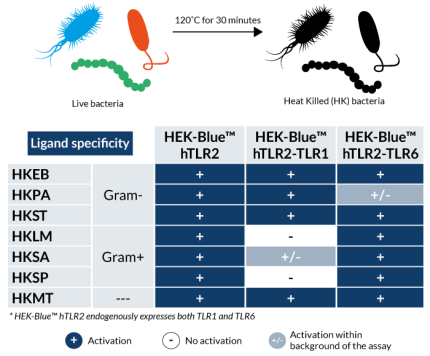TLR2 activation with whole bacteria
Toll-like receptor 2 (TLR2) forms a functional heterodimer at the cell surface with either TLR1 or TLR6, important for ligand specificity and downstream signaling. This not only expands the range of PAMPs that TLR2 can recognize but can also diversify the downstream signaling cascades [1]. Ultimately, this allows considerable plasticity in TLR2-dependent recognition and signaling. However, many studies of TLR2 signaling have been conducted using synthetic or purified ligands, such as Pam3CSK4 and peptidoglycan, and thus can be limited. Therefore, the use of whole bacteria, such as heat-killed bacteria, may offer novel insights into the full range of potential responses that follow TLR2 activation.
InvivoGen offers a collection of freeze-dried preparations of heat-killed (HK) Gram-positive (e.g. Staphylococcus aureus and Listeria monocytogenes) and Gram-negative bacteria (e.g. Pseudomonas aeruginosa and Salmonella typhimurium). Furthermore, we have functionally validated the HK bacteria on our HEK-Blue™ hTLR2 cell collection to identify their potential to activate TLR2-TLR1 or TLR2-TLR6, or both (see figure).
Applications of InvivoGen’s Heat-Killed bacteria include:
- To generate a positive control for dead-cell staining or, on the other hand, negative control for studies requiring metabolically-active cells.
- For endocytosis studies.
- When live bacteria are not able to be used (e.g. anti-cancer or cancer-promoting effects of bacteria in MTT assays).
References:
1. Oliveira-Nascimento, L. et al. 2012. The Role of TLR2 in Infection and Immunity. Front Immunol 3, 79.
